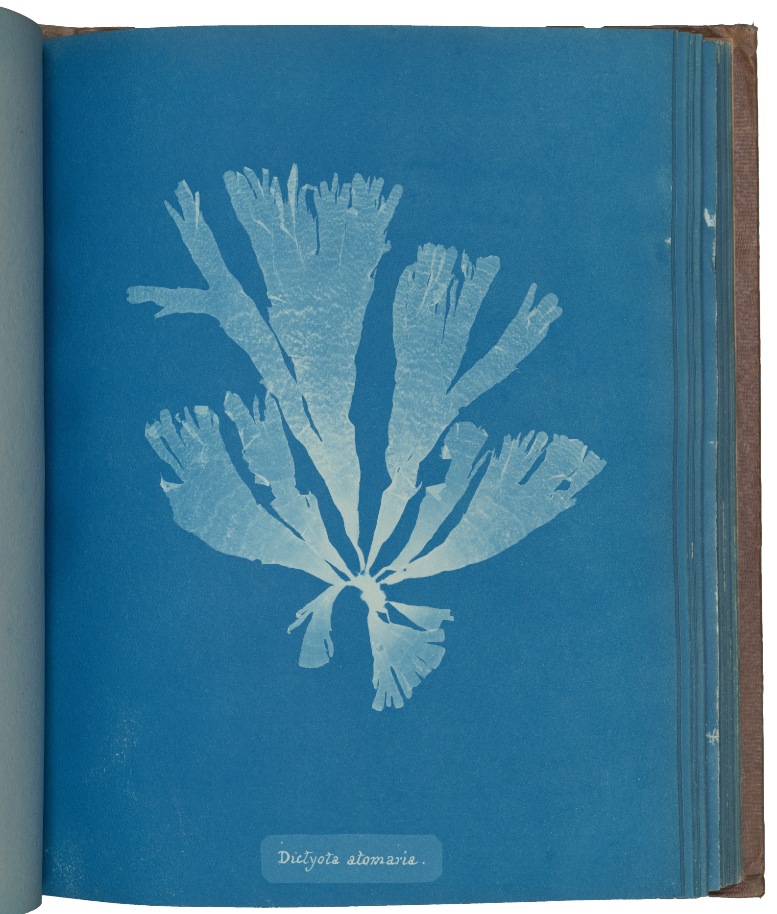
Anna Atkins, Dictyota atomaria, from Photographs of British Algae: Cyanotype Impressions, c. 1853, cyanotype, 25.3 x 20 cm (The Metropolitan Museum of Art)
Who was Anna Atkins?
We are looking at a white-ish blue, organically-shaped form radiating from a central point, and surrounded by a rich, flat cyan-blue tone. Little here gives a clue as to what this is—Is it a drawing? A plant? A print?—but a small cursive label at the bottom offers our first clue, Dityota atomaria. This Latin name for a species of algae suggests a scientific origin—perhaps that this is a botanical specimen. In fact, we are looking at a photograph on paper by Anna Atkins of a single dried piece of British algae. Today one might view a photograph by Atkins framed on a gallery wall or alone on a website, but originally her works were part of the book Photographs of British Algae: Cyanotype Impressions, which she self published by hand in 1843. The book, created just four years after the publicized invention of photography, was entirely printed with cyanotype photographs, a newly discovered method for fixing light impressions on paper.
Although Atkins is often known for these bright-blue photographs, she studied botany and scientific illustration for her entire life. In 19th-century Victorian England, women were not permitted to be professional scientists, and were known as “amateurs.” They were not admitted to scientific societies, employed to conduct research, or able to publish or present their work. Despite these societal restrictions, Atkins’s 1843 book of algae was the first-ever published book of photographs. Atkins’s interest in science and botany developed from an early age with the help of her father John George Children, a well-known chemist and a member of the United Kingdom’s The Royal Society. Atkin’s marriage to the wealthy merchant John Pelly Atkins offered both financial stability and support as she pursued these interests in botany and photography. After her first early foray into photography just after its discovery, Atkins worked with botanical specimens and cyanotypes for over twenty years, producing a huge body of work that today sits somewhere in-between works of art and works of science.
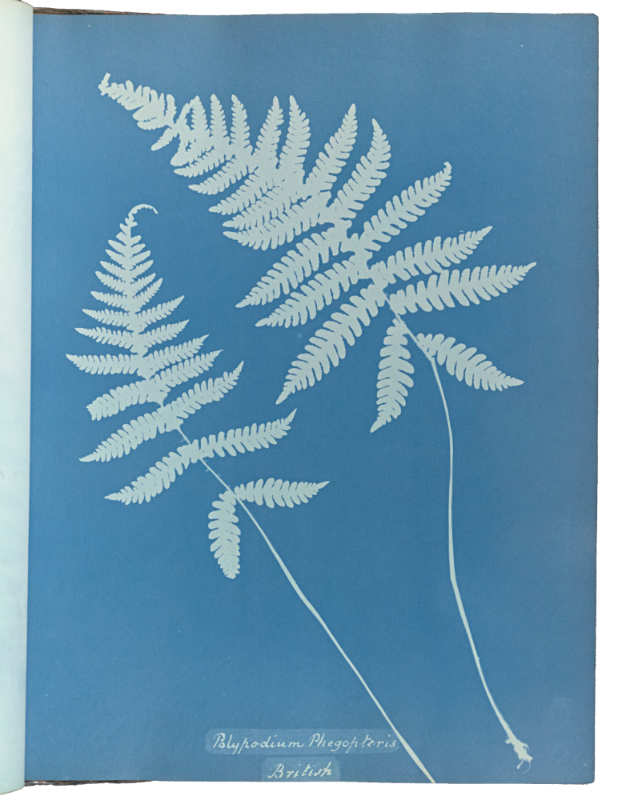
Anna Atkins and Anne Dixon, Polypodium phegopteris, 1853, cyanotype, 25.4 × 19.4 cm (The J. Paul Getty Museum)
Botanical illustration in the 19th century
Although today Atkins’s prints are sold and viewed as art, they were originally made as botanical illustrations. Before the invention of photography, illustrating botanical specimens was a major challenge. Etchings and engravings were slow and expensive, and not ideal for illustrating hundreds of different species. Additionally, the act of translating the specimen from drawing to plate to print could introduce errors. Like a game of telephone, the final print might not be an accurate reproduction of the original object. Some printers solved these issues by inking the specimens directly to create impressions of the plant matter, but this destroyed the original piece, and only allowed for very small runs of prints. Finally, many collectors created their own guides, known as herbaria, or books full of dried and pressed botanical specimens. But herbaria were full of delicate organic matter and were hard to share and distribute. Although the Atkins herbarium is not digitized online, you can explore Emily Dickinson’s herbarium, a complete and well-preserved example, through Harvard’s Houghton Library.
Atkins’s cyanotype process was meant to solve some of these challenges. Because its images were created directly by light, they were thought to have eliminated the subjective hand of the illustrator. In reality, Atkins made many choices in her works, but the direct impression onto the sheet of paper was done only by light and chemistry. Additionally, the cyanotype process did not damage the original specimens, it was reproducible, and long-lasting. We can see all of this at play in the sharply rendered Polypodium phegopteris above. Yet, the cyanotype process was also imperfect. Note how this image lacks certain helpful details such as the fern’s coloration and surface texture, as well as the shape of its root-balls and its microscopic spores. As printing techniques improved, the cyanotype did not emerge as the ideal solution. Instead, as botanical illustration modernized, it moved to photography, lithography, and hybrid forms such as photogravure, which combines the technology of acid copper etching with light-sensitive photographic chemicals.
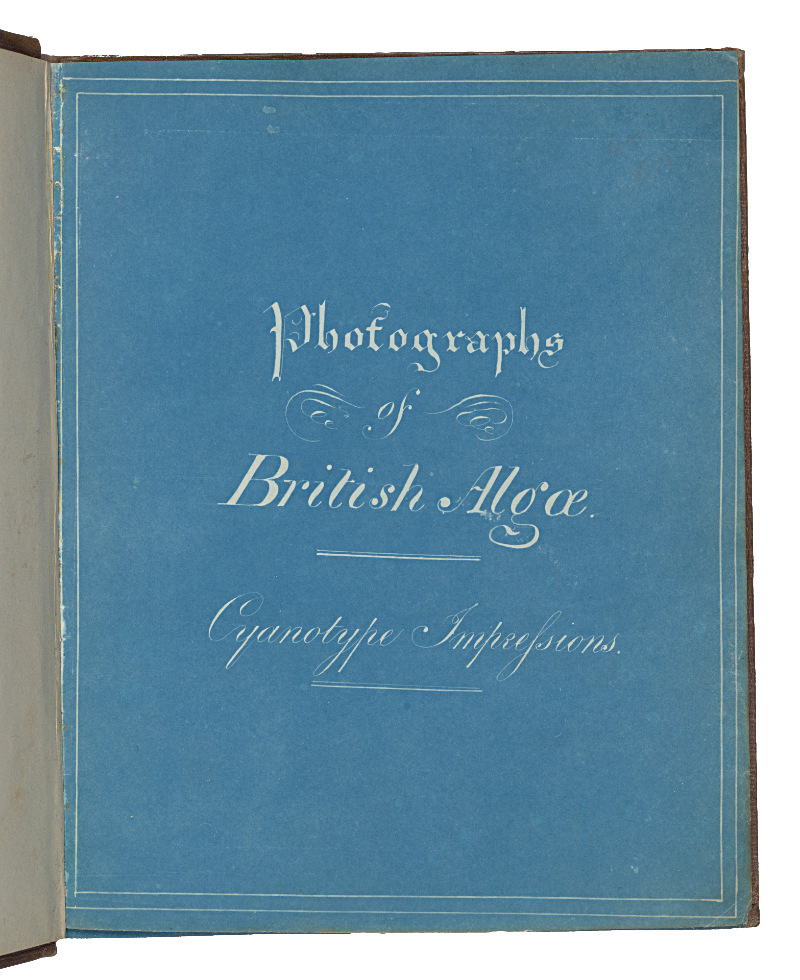
Anna Atkins, Photographs of British Algae: Cyanotype Impressions, c. 1853, 25.3 x 20 cm (The Metropolitan Museum of Art)
What is the Cyanotype Process?
To capture her photographs of algae, Atkins first applied a mixture of UV-sensitive iron compounds to plain paper. After the paper dried, she placed a dried botanical specimen and a label, written on a piece of translucent oiled paper, directly against the newly light-sensitive paper. This composition was then exposed to bright sunlight for several minutes. Because these photographs are made without a camera or lens, Atkins had to press the specimen flat against the paper with a piece of clear glass so it would render sharp lines. During this exposure, the object would block the sunlight from reaching the paper (in effect casting a shadow). Finally, the exposed cyanotype photograph was washed with plain water. As the print dried, areas that received sunlight turn bright blue, and areas where the light was blocked by the specimen or the label, remained white. In the algae Dityota atomaria above, for example, we can see that the center of the specimen blocked more sunlight and remained brighter than the translucent “leaves” radiating around it. This type of image, with shadowed areas becoming lighter, and the sunlit areas becoming darker, is known as a negative.
Sir John Herschel discovered this photographic process in 1842, coining the term “cyanotype,” after the Greek word for dark blue: “cyan.” At the time, this process was barely published and was not widely recognized. Herschel himself likely saw it as a failure because he was seeking a direct-positive process in which the final image looks similar to the actual object or scene, not the negative process he discovered, in which the print is the reverse of the scene. Atkins likely heard about cyanotypes directly from Hershel himself: the two families were close personal friends. In fact, Atkins’s works are the only major use of the process until its commercialization in the 1870s. Despite their slow adoption, but thanks to their low cost and easy reproducibility, cyanotypes were the only early photographic process to be used well into the 20th century in the form of architectural blueprints. Even today, you can buy pre-prepared cyanotype paper for making your own sun-prints.
Atkins produced a huge volume of botanical illustration prints using this process. She distributed them to academic friends and scientific institutions (Sir John Herschel got a copy, as did The British Museum). A recent survey by the New York Public Library found that Atkins self-published at least 26 separate volumes and thousands of unique prints scattered in museums and private collections. An undertaking of this magnitude required access to both chemicals and collections of identified botanical specimens. Although Atkins may have collected some specimens herself, most of the algae and fern species in her images were given or lent to her. Her father’s connections to botanists and collectors likely helped Atkins obtain the steady stream of specimens needed for her ambitious books. At the same time, his knowledge of chemistry ensured she had access to the necessary chemicals for her project.
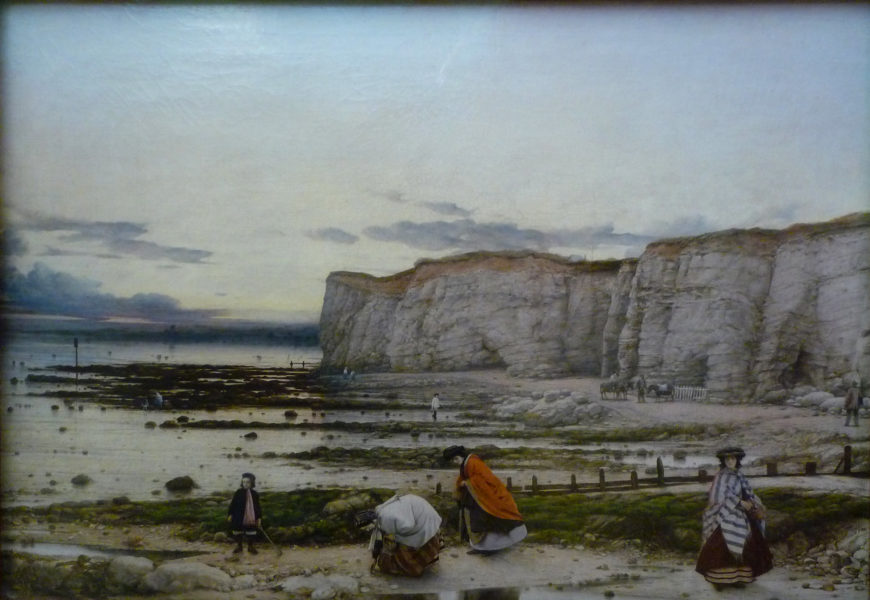
William Dyce, Pegwell Bay, Kent—a Recollection of October 5th 1858, 1858–60, oil on canvas, 25 x 35 inches (Tate Britain, London)
Between Science and Art
Atkins’s books contributed to a burgeoning interest in science, botany, and collecting in England during the 19th century. She was producing these works at a time when science took a fervent interest in the natural world, exemplified by Darwin’s Origin of Species (1859), among many other works. This interest in science and natural history was also transforming shorelines, including those in Atkins’s hometown of Kent, into sites of scientific inquiry. Paintings such as Pegwell Bay, Kent—a Recollection of October 5th 1858 by William Dyce celebrated the shoreline’s new role as a place for leisure and learning by showing the female members of Dyce’s own family collecting shells and fossils at the foot of the cliffs during low tide. Figures such as Atkins as well as the British paleontologist Mary Anning revealed the shore to be both a meeting point between geology and botany, as well as a space where women could practice scientific research.
Atkins’s first cyanotype project attempted to add imagery to William Harvey’s unillustrated Manual of British Algae (1841). Her nomenclature was based on this published guide, as were the specimens she sought out. Although her photographs originally had a scientific purpose, today they are of limited use because Atkins left out crucial details about the specimens’ sites and dates of collection. As Atkins continued to engage with cyanotypes, and as she branched out from her project with algae, we can see how she experimented with the medium and developed her own aesthetic.
While the algae photographs are generally sparsely composed, her careful attention to detail and quality is evidenced by the consistency of her prints among her many volumes. In her later projects with ferns and other plants, her interest in botany, collecting, and illustration merge with an interest in the creative side of selecting and placing the specimens. In Polypodium phegopteris above, for example, note the diagonal flow of the image, and the doubling of specimens that gently curve towards one another. This composition, minimal as it is, pushes beyond the utilitarian needs of botanical illustration. Similarly, compare the sparse cover of Photographs of British Algae: Cyanotype Impressions above with the ornate and complex cover of Cyanotypes of British and Foreign Ferns below.
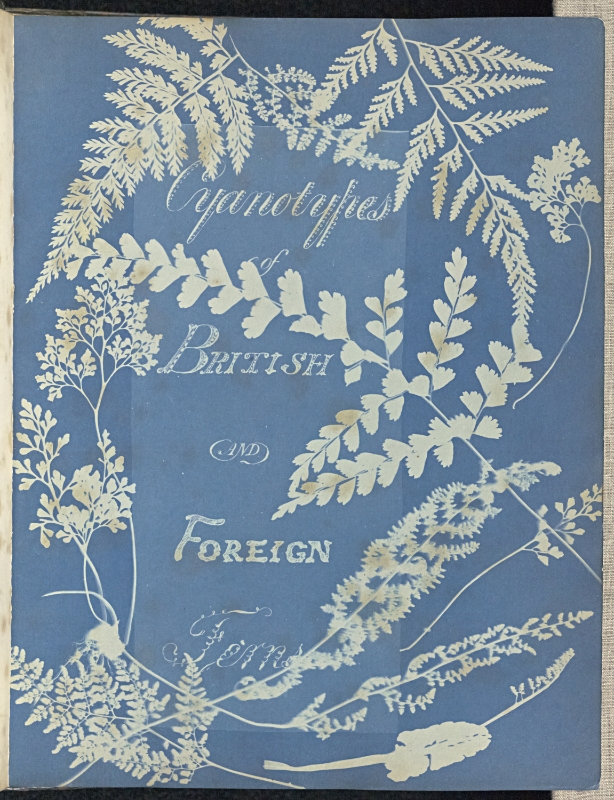
Anna Atkins, Cyanotypes of British and Foreign Ferns, 1853, 25.4 × 19.4 cm (The J. Paul Getty Museum)
Today, Atkins’s work is widely collected and celebrated. It opens up many areas of inquiry—from the origins of photography and modern botany, to aristocratic society, and even gender roles in Victorian England. Because of these intersections, we cannot understand the context of her work without understanding its scientific underpinnings. Yet, at the same time, her works, and her adoption of the innovative and lasting cyanotype process, has inspired countless artists to work with and experiment with the medium.
Additional resources:
Learn more about the cyanotype process
Maika Pollack, “The Woman Who Made the World’s First Photobook,” Aperture (January 11, 2019)
The Forgotten Story of Anna Atkins from the Google Cultural Center
Larry J. Schaafand Joshua Chuang Sun Gardens: Cyanotypes by Anna Atkins (New York: New York Public Library and Prestel, 2018)

